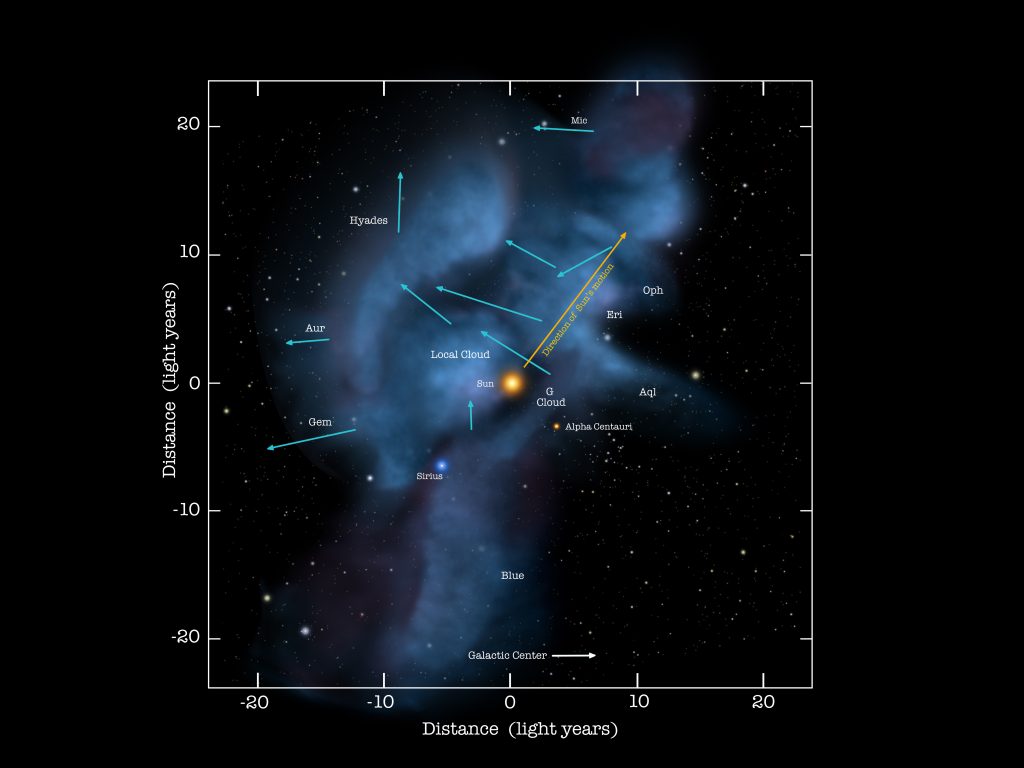Foto astronómica del día
Descripción original:
The Local Fluff
The Local Fluff
2024-12-22
The stars are not alone. In the disk of our Milky Way Galaxy, about 10 percent of visible matter is in the form of gas called the interstellar medium (ISM). The ISM is not uniform and shows patchiness even near our Sun. It can be quite difficult to detect the local ISM because it is so tenuous and emits so little light. This mostly hydrogen gas, however, absorbs some very specific colors that can be detected in the light of the nearest stars. A working map of the local ISM within 20 light-years, based on ongoing observations and particle detections from the Earth-orbiting Interstellar Boundary Exporer satellite (IBEX), is shown here. These observations indicate that our Sun is moving through a Local Interstellar Cloud as this cloud flows outwards from the Scorpius-Centaurus Association star forming region. Our Sun may exit the Local Cloud, also called the Local Fluff, during the next 10,000 years. Much remains unknown about the local ISM, including details of its distribution, its origin, and how it affects the Sun and the Earth. Unexpectedly, IBEX spacecraft measurements indicate that the direction from which neutral interstellar particles flow through our Solar System is changing. APOD Year in Review: Night Sky Network Presentation for 2024
Copyright:
Comentario de la AI
Descubriendo la ‘Pelusa Local’: La nube que rodea nuestro Sistema Solar
El misterio del medio interestelar local
Las estrellas no están solas en el vasto disco de nuestra galaxia, la Vía Láctea. Aproximadamente el 10% de la materia visible en este disco está compuesta por gas conocido como el medio interestelar (ISM). Este medio no es uniforme y presenta variaciones incluso cerca de nuestro Sol, lo que hace su detección todo un desafío debido a su escasa emisión de luz.
La Pelusa Local y sus características
Este gas, compuesto mayormente de hidrógeno, absorbe algunos colores específicos detectables en la luz de las estrellas más cercanas. Gracias a las observaciones y detecciones de partículas realizadas por el satélite Interstellar Boundary Explorer (IBEX) en órbita terrestre, hemos podido elaborar un mapa del ISM local dentro de un radio de 20 años luz.
Los datos revelan que nuestro Sol se está moviendo a través de una nube interestelar local, conocida como la ‘Pelusa Local’, que fluye hacia afuera desde la región de formación estelar de la Asociación Escorpión-Centauro. Se espera que nuestro Sol abandone esta nube durante los próximos 10,000 años.
Desafíos y descubrimientos futuros
Aún existen muchas incógnitas sobre el ISM local, como su distribución, su origen y cómo influye en el Sol y la Tierra. Sorprendentemente, las mediciones de la nave espacial IBEX indican que la dirección desde la cual los neutrales inter-estelares fluyen por nuestro Sistema Solar está cambiando.


